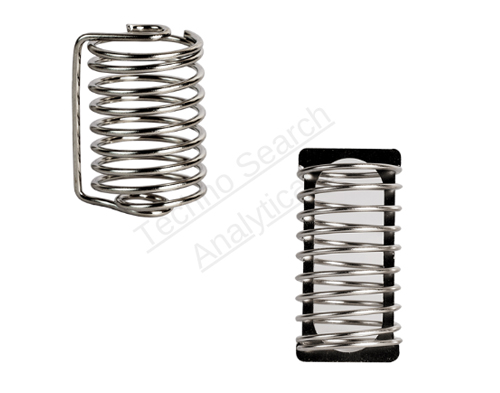At Technosearch, a leading manufacturer based in Mumbai, we offer premium sinkers for dissolution testing. The size of the sinker depends on the size of the capsule. Capsule sinker is used to sink the dosage form which would otherwise float in the absence of dissolution sinker. According to the U.S. Pharmacopeia, an alternative to Apparatus 2 is the use of a non-reactive stainless steel wire helix as a 'sinker.'. Technosearch manufactures various types of sinkers such as Cage type sinkers, Spring type sinkers, Helical coil sinkers, Metformin sinkers, Japanese sinker, 3 prong sinkers
Different Class of Dissolution sinkers :
1. Longitudinal Sinkers : These sinkers make contact with the dosage forms along their long axis.
2. Lateral Sinkers : These either wrap around or contact the middle of capsule dosage forms, such as where the top and bottom halves of a capsule shell meet.
3. Screen Enclosures : These include two types: a wire cage that holds the capsule or a circular piece of wire screen placed on top of the capsule.
Internal Weights: These consist of two steel ball bearings, one inserted into each end of the capsule.
Technosearch Dissolution Sinker :
Sr. no |
Sinker type |
1 |
Sinker 5mm ID X 15.5mm OD |
2 |
Sinker 6mm ID X 18mm OD |
3 |
Sinker 8mm ID X 23mm OD |
4 |
Sinker 11mm ID X 23mm OD |
5 |
Cage type Sinker (Small/ Big) |
6 |
Spring type Sinker (Small/ Big) |
7 |
Helical coil Sinker |
8 |
Metformin Sinker |
9 |
Japanese Sinker |
10 |
3 Prong Sinker |
Selecting the appropriate sinker depends on the specific type of tablet or capsule being tested. Generally, consider the following guidelines :
Non-Contact : The sinker should ideally not touch the tablet to avoid affecting the dissolution rate.
Size Options : Sinkers are available in various sizes to fit most tablet and capsule dimensions.
Weight : Use the minimum amount of weight necessary to achieve the desired effect.
Coating : Coated sinkers are recommended if there is a risk of reaction between the steel and the tablet.
Basket-Type Sinkers : These can be effective, but ensure that the tablet’s outer coating does not block the mesh.
Wire Spirals : Should be as wide as possible to prevent clogging, which can affect the dissolution rate.
Japanese Sinkers : Adhere to strict dimensional standards specified by the Japanese Pharmacopeia (JP).

